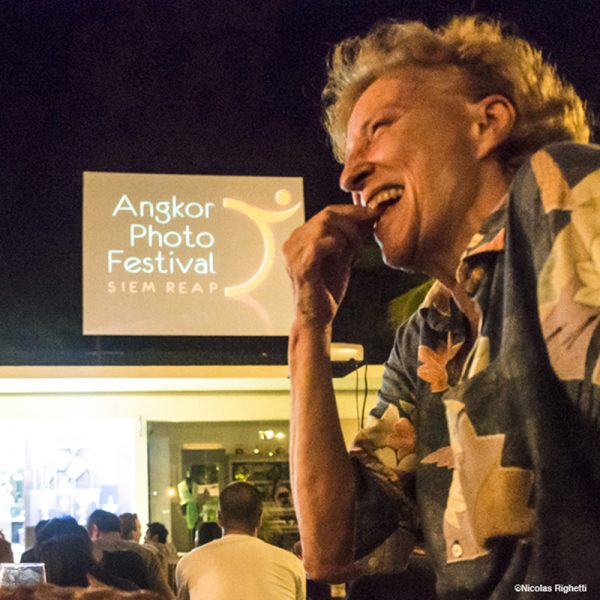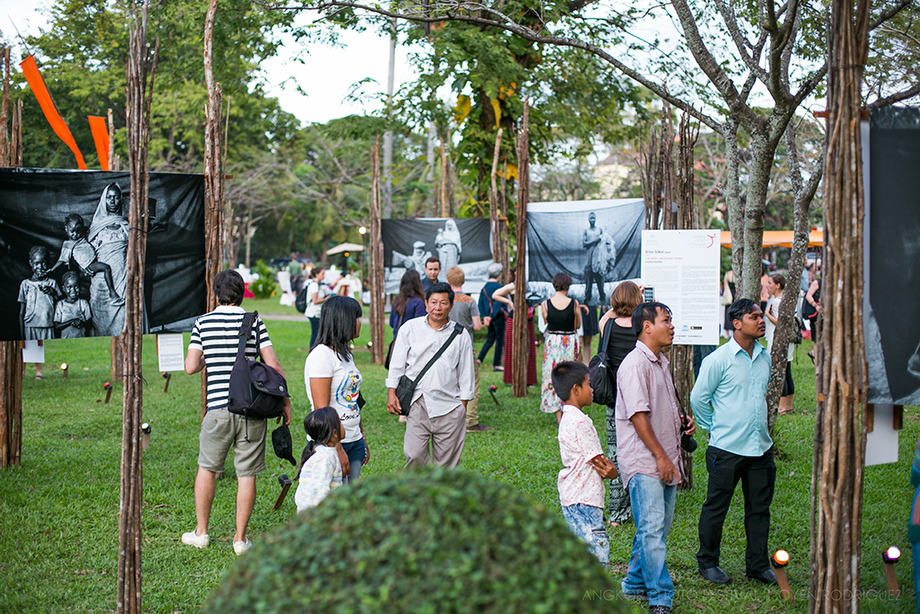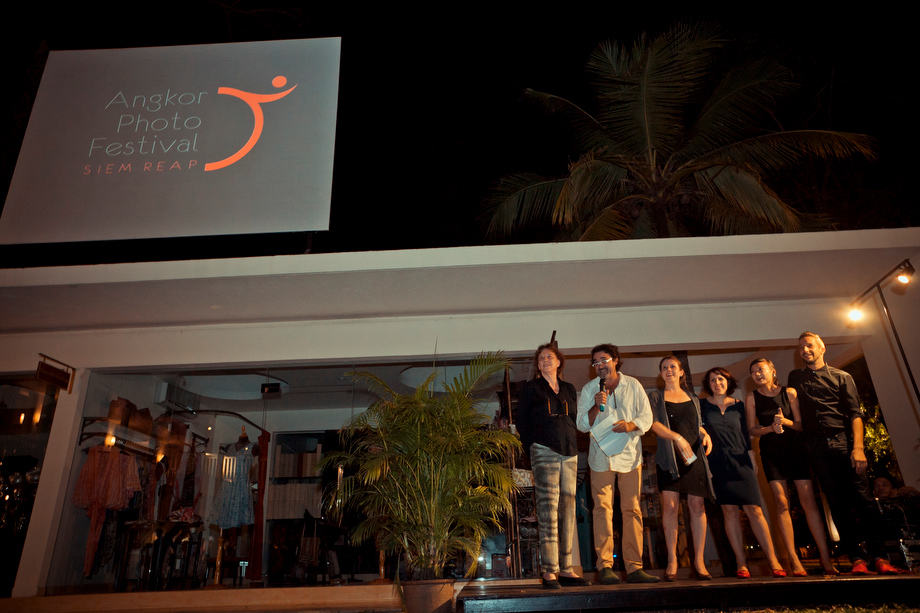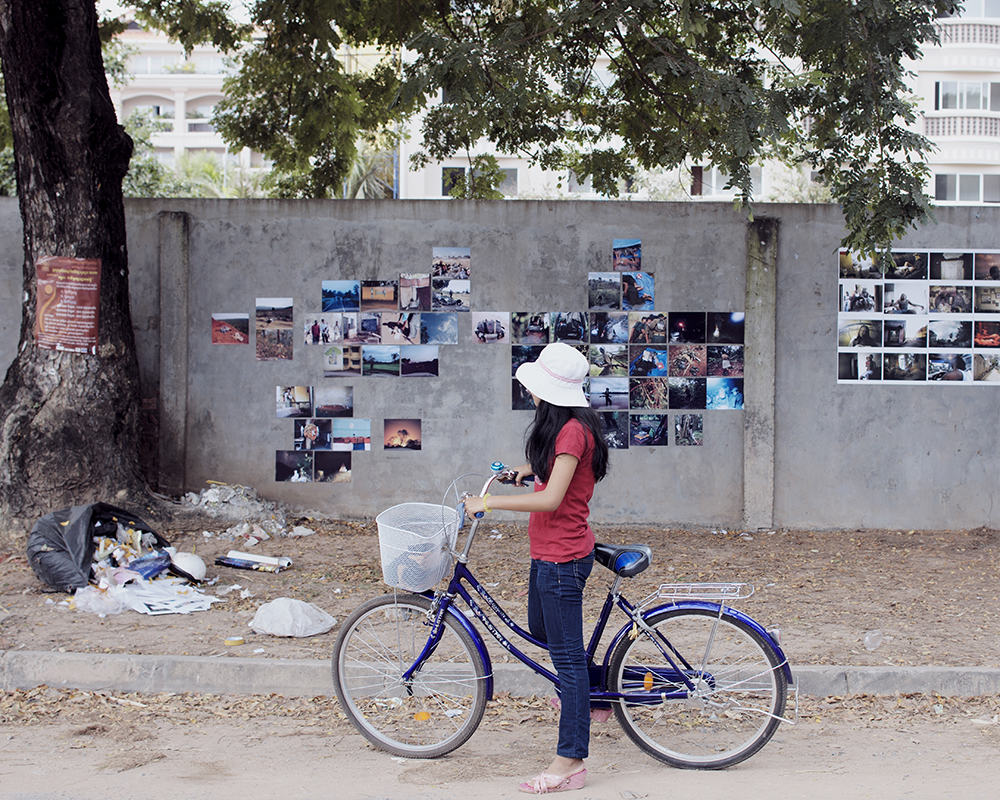
2013 – Evening of slide shows at FCC
Angkor Photo Festival is the longest running photo festival in Southeast Asia. From 29th November to 6th December this year, they will host and celebrate their 10th edition.
During a recent trip to China, I spent considerable time with Francoise Callier, Angkor’s Programme Coordinator since 2007. We spoke at length about photography and the festival, behind-the-scenes and front. Here are some highlights as shared in a post-trip interview.
Thank you for your time Francoise. Please introduce yourself and your role at Angkor Photo Festival.
I’m Belgian, and have been living in Paris since 1983. From 1983-1998, I worked at 2eBureau, directed by Sylvie Grumbach. I was the photographer’s agent of photographers such as Helmut Newton, Jean-Paul Goude, Max Vadukul and more. Following this, from 1990 to 1998, I was doing press promotion at 2eBureau for “Visa pour l’Image – Perpignan”. During this time, for three years, I was also the French correspondent for Corbis, in charge of filling the archive. I’ve been the programme coordinator of the Angkor Photo Festival from 2007 till today, and am also involved in Anjali House, a shelter for 100 underprivileged children of Siem Reap founded by the festival in 2005. Anjali House is involved with the festival through the “Anjali Photo Workshops”, and during the year I’m involved with doing editing with them for books, slideshows and exhibitions of the kids work. Thanks to the tutors volunteering their time, some of the kids have become really good at photography.
This year Angkor Photo Festival celebrates its 10th Anniversary. Congratulations! A decade is a long time. What’s the secret?
It isn’t really a secret. We have a team who are all very committed to seeing the Angkor Photo Festival realised year after year. We also always get a lot of positive feedback from photographers and visitors that let us know that they want a platform like this, and that it has been beneficial for them.
What has changed since the Festival was first founded? Or is it still the same?
Initially the festival was under different management, and the way the festival is right now has been since around 2008. Since then, there hasn’t been any major changes. Of course the festival is growing, but the friendly atmosphere remains, which is very important for us. One new thing added along the way is the Blowup Angkor, a public event initiated by the Blindboys, and also for the past two years, we have started to include more structured portfolios reviews and afternoon sessions where photographers can talk about their new books or make screenings of their last projects. This is all based on feedback from photographers on what is useful for them.
Another thing is that we are seeing a lot more submissions to the festival from Asian photographers, and applications to the workshops than when we first started.

©Halim Berbar_Sipa Press05
Can you tell us a bit about the process behind Angkor’s program and exhibition curation over the years?
In the first quarter of the year, we announce an open call for submissions – in 2013, we received 1300 submissions from 75 countries. Besides that, I spend a lot of time researching on the Internet for more work, and I also try to contact some photographers who I have known and admired for a long time. And some of my friends whose professional expertise I trust have sent me recommendations to great stories.
What do you think are some of the biggest achievements of Angkor Photo Festival? And likewise regrets over the years?
What is really satisfying is when we are able to help expose the work of emergent photographers in other countries, festivals and galleries. Also, every year we have a great group of students from the Angkor Photo Workshops, and it is wonderful to see the alumni of the workshops succeed in their careers after they’ve been with us.
And likewise, what is the funniest thing that has happened at Angkor Photo Festival?
It is hard to remember, but the monsoon floods in 2011 was very bad in Siem Reap and for many days the team had to swim to the office. There were frogs and fishes in the office too when it was flooded.
What about the most memorable guest?
It is very difficult to say, we’ve had so many great visitors and guests. Perhaps Roger Ballen, who made a very memorable presentation during one of the evening projections. Also, Phillip Jones Griffiths, who got very involved when he was here. He contributed and helped us out a lot especially at the workshops.
Tell us something we might not know about Angkor Photo Festival.
That it’s an enormous challenge to organize the festival with a team of only 3 people. Apart from me, there’s Jean-Yves Navel, founder and director and Jessica Lim, Asia coordinator. We are very firm on keeping all events and our call for submissions free-of-charge for all participants and visitors, and so we are reliant on finding other sources of funding for the festival.
I know audiences from Angkor Photo Festival travel to PhotoPhnomPenh Festival which happens immediately after. Do both festivals work closely to ensure different content and programming is offered?
We are totally separated, and each of the festivals has it’s own area of speciality.

2013- Exhibition by Brian Sokol “The Most Important Thing” for UNHCR
There are more Festivals now popping up across Southeast Asia. How do you see Angkor’s position and relevance in this growing circuit of Festivals?
Having more festivals in the region hopefully means that more photographers can benefit because they will have more platforms to show their work, and also it will be good for the general industry in the region because it creates more awareness and exposure. We have been around the longest in Southeast Asia and we will keep to our strengths, and also it would be nice to have interesting collaborations and sharing with other festivals.
Having more festivals coming up also means that we want to emphasize once again the role that education has with our festival. Now that there are more platforms and ways for photographers to share their work, it is important for us to ensure at the same time that young and emerging photographers have access to learning and improving their photography through our workshops.
I’ve been to Angkor before. What was nice was the relaxed atmosphere and the ease in which someone new could meet people. It felt small and cosy. Is that a conscious effort and can a festival get too big?
That is great you noticed that because yes it’s a conscious effort, we want everyone to be able to feel like they can meet and talk with everybody there. It is better to form friendships than to just make contacts. If the festival gets too big, it might lose its original spirit and we want to be able to remain close to all the photographers so that we can get to know them, and to be able to help them better.
What are the pros and cons of hosting the festival in Siem Reap?
Only good things – it is a small town, easy for visitors to get around to all our venues, very relaxed, cheap and affordable for photographers to spend time here compared to going to America or Europe, and with a lot of meeting places and sightseeing to do if you have the time to visit the temples.
Looking towards the future, how do you see Photo Festivals in general, and Angkor specifically, evolving if at all – in terms of function and meaning?
All photo festivals have their own mission and objectives, which will of course change over time depending on their environment and what their aim is. For us, we have been evolving in an organic way, based on feedback on what photographers need when they are here, and also based on how we can keep contributing in our own way to photography in the region. For the 10th Edition, we are taking a good look again at our mission to make sure that we are on the right track.
For example, after all these years we now have a growing group of alumni from the workshops who return to participate and be a part of our events. They have created a cycle of giving back and this is something that we want to nurture and encourage.
The Angkor Workshops have established a reputation for churning out a healthy rate of young working photographers in the region. It appears to be a key component of Angkor’s success wouldn’t you agree?
It is not just a key component but the heart of the festival. It is such a major part of who we are, how we started, and what we want to do. A lot of them come back every year and the festival has become a meeting place for them to see each other, and it means we all feel like a part of a big family. They are also seeing each other grow and develop in their own photography over the years, helping each other, collaborating on projects. Photographers are our best ambassadors, it means a lot to us that they feel welcomed and comfortable with us.

© rakzphotography
Photography and photographers in general are having tough financial times and we’d assume this also affects Festivals. Share with us about Angkor’s funding situation.
Yes, this is a major problem for everyone, even the photo festivals that have been around for a long time. In the industry everyone knows it is getting more and more difficult to find funding now. When organisations and companies face budget cuts, it is funding to projects like ours that gets affected first. Since last year it has been very difficult for us, and we’re always trying to adapt and look for new ways to solve this problem.
You have a strong bond with photography in Asia. People refer to your home in Paris as a quasi hotel for young Asian photographers. How did it all start?
If I remember, Munem Wasif was the first guest. Then other ones came and spread the word… Now, I have a lot of regular ‘customers’. I’m sorry to say I can’t take more new ones, it is getting crowded sometimes!
What are your thoughts on the state of photography in Cambodia and Southeast Asia?
In Cambodia, there is a growing group of young people who are becoming more involved in photography. The quality is improving and we are seeing more good photographers emerge – last year the winner of the 2013 Photo Prize was Neak Sophal, a graduate from Phnom Penh’s University of Fine Arts.
In general, I would say that there is still a lot more room for photographers in Southeast Asia to do different things and to try to pursue more unique story ideas and topics. Every year during the submissions I’m inundated with stories about the same topics and issues, and also covered in the same way. It can be difficult as I prefer not to show similar things year after year. I would love to discover and see more things that I’m not aware of or that I haven’t seen before.
As a curator, what type of photography moves you, and what doesn’t?
I can be quite eclectic in my selections. I’m more interested in documentary-style photography because it is full of life, and asking real questions. Personal stories move me a lot. It is about whether I can understand what is it the photographer really wants to say or tell – with more conceptual work, sometimes that isn’t very clear.
What would your advice be to young photographers eager to learn and grow?
To keep looking at a lot of different work, and try to understand why they find it ‘good’ or ‘bad’, and to why they like it or not. To keep true to their own style and self, and not to copy what is trendy. To be more careful with how they edit their work and not to be afraid to do more long-term projects that go in-depth.
You have announced the dates for this year’s festival, so last question, what can we expect from this year’s 10th anniversary celebration?
The dates will be November 29-December 6.
For our 10th anniversary, we plan to have a lot more outdoor exhibitions to be able to involve more of the local community. We’re also thinking to increase the size of the Angkor Photo Workshops to allow for more participants. We have a lot of great projects in the pipeline, but let’s wait for a bit because we need to be sure we can afford to have them all. Cross your fingers for us!
Thanks Francoise and an advanced Happy 10th Anniversary. Hope to see you again at the Festival!
Share


Comments 2
Pingback: Join us at Angkor Photo Festival, SE Asia's longest running festival of photography | Invisible Ph t grapher Asia (IPA) | 亞洲隱形攝影師
Pingback: List of Photo Festivals in Asia 2014 | Invisible Ph t grapher Asia (IPA)